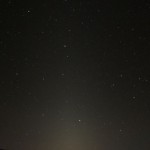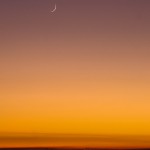Tomorrow morning a beautiful trio of two planets and the Moon will rise in the dawn. Venus will rise first at 5:02HST, followed shortly thereafter by the Moon and Mercury nearly together. The trio will form a neat triangle about 6° across. The planets will rise an hour before the light of dawn spreads across the sky and nearly two hours before sunrise.
Tag: Venus
Five Bright Planets in the Dawn
All five planets that are visible to the unaided eye can be found in the dawn for the next few weeks. Jupiter, Saturn, Venus and Mars have been visible in the dawn for some time now. Arriving late to the party is Mercury, just rising out of the glow of dawn. Mercury is headed for maximum elongation on February 7th, rising to 24° ahead of the rising Sun. The line of planets will persist for a week or two after that as Mercury drops back into the glow of dawn after elongation.

Together the five planets neatly outline the ecliptic, the plane of our solar system revealed by simply connecting the dots across the sky. As dawn approaches, but before the start of twilight around 6am, look for the zodiacal light, the bright glow of interplanetary dust also seen along the ecliptic.
Venus and Saturn
On the morning of January 8th and 9th Venus and Saturn will be quite close in the dawn.

As the pair rises on the morning of the 8th they will be only 32′ apart, easily close enough to fit in the low power field of most amateur telescopes. The morning of the 9th will see the pair again close, only 34′ separation. They will slide past each other much closer, about 5′ apart, but this will not be visible from the central Pacific as it occurs around 11:42 HST on the 8th, while the planets are below the horizon.
Moon, Venus and Saturn
Tomorrow’s dawn, January 6th, will see the Moon, Venus and Saturn in a nice conjunction. A beautiful 12% illuminated crescent Moon will be a bit over 4° above Venus shining brightly at -4 magnituide. Saturn will be another 3° below Venus. As an added accent the bright star Antares will be 6° south of the trio.
Venus at Maximum Elongation
Today Venus is at maximum elongation, as high in the dawn sky as it will get for this morning apparition, about 46°. After today the planet will begin its long slide back into the glare of dawn. It will disappear from view around the beginning of May, 2016 and reach superior conjunction on June 6th, 2016.
Venus Appears in the Dawn
The bright planet Venus will appear in the dawn sky over the next couple weeks, climbing higher to become the morning star for the remainder of 2015. It is currently 15° from the Sun and shining at magnitude -4.2, bright enough to be seen against the dawn sky. It will reach maximum elongation on October 26th, 46° above the rising Sun.
Venus at Inferior Conjunction
Today Venus is at inferior conjunction, passing between the Earth and Sun. It will reappear in the dawn sky near the end of the month to become the morning star for the remainder of 2015 and well into 2016. The planet will reach maximum elongation on October 26th at 46° from the Sun.
Venus Disappears into the Sunset
The 2015 evening apparition of Venus is drawing to a close. Already quite low in the sky at sunset the planet will disappear into the bright glow over the next couple weeks. Venus will pass through inferior conjunction on August 15th and reappear in the dawn during the first weeks of September.
Accompanying Venus into solar conjuntion is the bright planet Jupiter, continuing their dance in the sunset.
Conjunction
I missed the closest approach of Venus and Jupiter. Not for lack of trying. I had set up the telescope and camera in the driveway. A clear afternoon clouded over at sunset, leaving me only glimpses of the planets through a fleeting gap in the clouds. I had time to focus enough to see the crescent of Venus, which promptly faded from sight.
The next evening I am on the summit. No small telescope available, but I did have the camera to record a stunningly beautiful evening atop the mountain.

Venus and Jupiter Reminder
A reminder that this evening will see the close approach of Venus and Jupiter. Watching over the last week we have seen these two bright planets growing ever closer in the evening sky.
The closest approach will be about 0.3° tonight, June 30th at 16:14HST. They will be slightly further apart several hours later at sunset.
This is the best opportunity to see the pair at their closest for observer in Hawaiʻi. If you want to see the closest approach you can also try to observe the conjunction in the late afternoon sky. Both planets are bright enough to see in the daytime.
After this the pair will separate slowly and disappear into the sunset glow together.
At their closest the two will be easily close enough to bee seen together in the low power view of amateur telescopes. It makes a fascinating sight to see the two planets together in the eyepiece.
